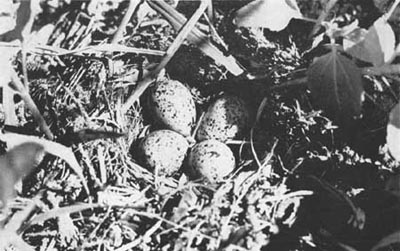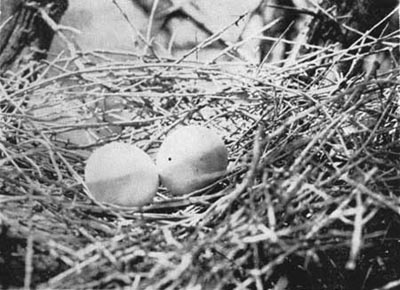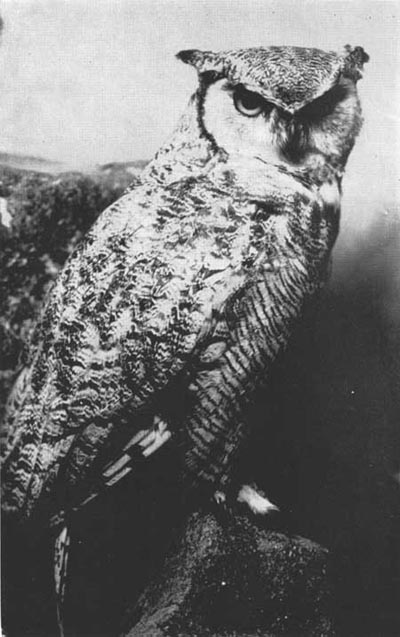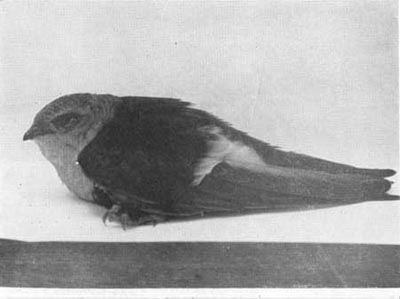|
ZION, BRYCE CANYON, CEDAR BREAKS
Birds of Zion, Bryce and Cedar Breaks |

|
Zion-Bryce Museum Bulletin
Number 5
THE BIRDS OF ZION, BRYCE, AND CEDAR BREAKS
DESCRIPTION OF SPECIES
(continued)
| DUSKY GROUSE (Dendrapagus obscurus obscurus). | |
| Field Marks: |
This is a large crow-sized bird, chicken-like in appearance. Male, general coloration is dark gray; tail blackish, tipped with a broad band of light gray. Female, upper parts brown, broadly mottled with black and buff; otherwise similar to male. |
| Occurrence: |
ZION. Uncommon permanent resident in the higher portions of the park. It has been seen at several places among the ponderosa pine and fir trees back of the canyon rim, but is apparently found in greatest numbers at Potato Hollow and vicinity. BRYCE CANYON. Uncommon permanent resident. It is found along the rim during the summer from Swamp Canyon to Rainbow Point, where it nests during June and July. During the winter it wanders below the rim in several places where the area is more protected against heavy snows. CEDAR BREAKS. Uncommon permanent resident. During the summer it is often seen along the forested rim of the canyon, but in the winter it is far less commonly observed. It nests in June and July. During the winter it is seldom found outside of the heavily wooded groves of fir and spruce. |
|
The call note of this grouse is easy to identify. It is commonly heard coming from the depths of the evergreen forest, and is composed of a series of hollow, low pitched notes that sound very much like someone working on an old wash board. The sounds start relatively strong and get weaker and weaker, until near the end they can scarcely be heard. It is very difficult to tell where the sounds come from; whether from near or far. Often it comes from a tree, where the bird sits motionless, weld hidden by its protective coloration. | |
| GAMBEL'S QUAIL (Lophortyx gambeli gambeli). | |
| Field Marks: |
Large robin size, plump. Male, upper parts brownish-gray; top of head chestnut edged with white; forehead dark gray; a black plume curves forward from the forehead; throat black, bordered with white; breast gray; a black patch on the belly; sides chestnut, prominently streaked with white. Female, similar to the male, but with the top of the head brown and lacking the black patch on the belly. |
| Occurrence: |
ZION. Common permanent resident in restricted localities in the lower portions of the park. Large flocks have been observed in Shunes Canyon and along North Creek. A covey used to inhabit Zion Canyon, but disappeared for no known reason in 1932. |
|
This is a bird of the desert country, being especially abundant around the mesquite and cats-claw groves in the Zion region. Often a large convoy will not fly when disturbed, but instead wild run along the ground from one bit of cover to another, all the while discussing the situation in a series of clucking calls and high pitched alarm notes. The male is often known locally as the "Red-head," because of his brightly colored crown patch. | |
| KILLDEER (Charadrius vociferus vociferus). | |
| Field Marks: |
Small robin-size. Adults, top of head and back brown; underparts and lining of wings white; breast with two black bands; rump and base of tail golden-red. |
| Occurrence: |
ZION. Uncommon summer resident along the streams and around ponds. Records have been obtained from Shunes Creek and Coalpits Wash. It nests during June. |
|
Without doubt this bird is almost as well known to every child as the familiar robin. Whether one lives along the ocean, in the city, or on the farm, he has undoubtedly observed the Killdeer, with its loud, shrill cries and conspicuous markings. It seldom stands very long in one spot without suddenly jerking its head and body upward in a teetering movement. On the ground, it has a habit of running, with a series of rapid gliding steps for a few feet, and then abruptly coming to a full stop, while it eyes the intruder closely to see what he may be up to. At Bryce it has been observed within two miles of the park boundary, so may occasionally enter the park. | |
|
| |
| SPOTTED SANDPIPER (Actitis macularia). | |
| Field Marks: |
A small shore bird about the size of a bluebird. Adults, upper parts brown; tail brown, the outer tail feathers barred with white; lower parts white, the breast covered with large, round, brownish-black spots. |
| Occurrence: |
ZION. Uncommon summer resident along the Virgin River. Nests in June or July. |
|
Along the edge of the river, during the warm days of the summer months, one often encounters this small sandpiper working industriously among the rocks, teetering nervously as it goes. In flight it travels with quick wing-beats, followed by the wings held stiffly outspread, with only the tips vibrating, Its call note is a single peet or double peet weet, often given in a series. | |
| BAND-TAILED PIGEON (Columba fasciata fasciata). | |
| Field Marks: |
Small crow-size. Adults, upper parts bluish-gray; underparts reddish-brown; lighter on stomach; dusky band across the middle of the tail; tail rounded. |
| Occurrence: |
ZION. Uncommon summer resident in the ponderosa pine belt in the higher reaches of the park. Reported nesting in 1934. All records have been obtained either around the rim of Great West Canyon or Potato Hollow. |
|
Unlike the familiar pigeon seen around the city or farm, the Band-tailed Pigeon is a dweller of the forests and rough terrain. It is usually seen on dead branches or snags of limbs of some huge pine. In flight the broad band on the tail is plainly visible. Little is known about these birds in this region, but records obtained throughout the summer months indicate that they breed in the park. Eighteen individuals were seen in one flock near the rim of Great West Canyon in the fall of 1942. | |
|
| |
| WESTERN MOURNING DOVE (Zenaidura macroura marginella). | |
| Field Marks: |
Robin size. Adults, general coloration ashy-brown; head bluish-gray; outer tail feathers broadly tipped with white; tail pointed. |
| Occurrence: |
ZION. Permanent resident, but common only during the summer and fall. Frequently observed in open situations around the main and tributary canyons. Less common in the higher portions of the park. Nests in June. BRYCE CANYON. Uncommon summer resident. Seen around the open glades in the ponderosa pine forest and along the canyon rim. |
|
Along the highways it is a common sight to see two or three of these birds sitting quietly on the ground at the edge of the road, or on any telephone wires that may be present. When alarmed, the bird usually raises its head quietly, eyes the intruder entirely motionless for a moment, and then departs with a sharp whistling of wings. The flight is rapid, with even wing-beats and graceful body outline. | |
| ROAD-RUNNER (Geococcyx californianus). | |
| Field Marks: |
Body crow-size, but with long tail, legs and bill. Adults, general coloration grayish-brown, heavily streaked with black; top of head black (often elevated as a crest); a crescent shaped patch of while on each wing which shows in flight; large white spots on the tips of the tail feathers. |
| Occurrence: |
ZION. Common permanent resident in the lower portions of the park, being especially partial to Oak Creek Canyon and Coal Pits Wash. Nests in June. |
|
The Road-runner, or "Chaparral Cock," as he is sometimes called, is undoubtedly the most picturesque bird found in the west today. There us definitely nothing beautiful about his general appearance; on the contrary, he will more likely produce laughter than admiration from all who see him. He is an agile runner, and seldom takes to the wing. If startled, he dashes rapidly for the nearest bush, long tail held stiffly behind him, head outstretched. When at a safe distance, he stops for a moment, belligerently eyeing the intruder, with crest rising and falling and the long tail rising up and down in pumphandle fashion. He is a terror to the lizards of the region, catching them with amazing dexterity and swallowing them whole. He is best known because of the occasional rattlesnakes that he kills and eats. | |
|
| |
| WESTERN HORNED OWL (Bubo virginianus pallescens). | |
| Field Marks: |
Larger than a seagull. Adults, buffy, mottled and streaked with dark brown, black and gray; ear tufts long and conspicuous. |
| Occurrence: |
ZION. Common permanent resident at all elevations in the park. BRYCE CANYON. Fairly common permanent resident throughout the park. |
|
The deep voice of the Horned Owl is familiar to any one who has ever spent any time around the woodlands. This is the largest and fiercest owl in the region, and, while it does some damage to such birds as the dusky grouse, it is especially beneficial in controlling the numbers of small rodents so prevalent in the valleys and in the high country meadows. But fierce and terrifying to most creatures as he is at night, the Horned Owl strikes no terror into the hearts of the birds during daylight hours, and it is not uncommon to find a group of jays making life miserable for him in some secluded canyon. | |
| NUTTALL'S POORWILL (Phalaenoptilus nuttallii nuttallii). | |
| Field Marks: |
Small robin size. Adults, plumage grayish-brown with black markings; throat white, bordered below with black; outer tail feathers white tipped; wings long. |
| Occurrence: |
ZION. Common summer resident throughout most of the park. Nests in June. |
|
The call o of the Poor-will in late evening from the slopes and canyon depths is the best indication that the bird is in the region, as it is somewhat difficult to find. It sits quietly on the ground. or makes short dashes into the air after insects. So well does it blend into its surroundings that the first indication that one has of its presence is when it suddenly flutters into the air from almost underfoot. At night its eye will glow when the headlights of a car are thrown on the bird. | |
|
| |
| WHITE THROATED SWIFT (Aeronautes saxatalis saxatalis). | |
| Field Marks: |
Sparrow size, with long, tapering wings. Adults, general color black; patch on flank, throat, breast and line down stomach white; tail long and some what forked. |
| Occurrence: |
ZION. Abundant summer resident from March to September. Is commonly seen around the cliffs, usually high above the canyon bottoms. Nests in May and June. BRYCE CANYON. Common summer resident around the cliffs. CEDAR BREAKS. Common spring migrant around the cliffs. |
|
The White-throated Swift is often confused with the Violet green Swallow, but can be told by the long narrow wings, which form a "taut-bow" silhouette, and by the lack of pure white on the stomach. Its flight is much more rapid than that of the swallow, and the wings, instead of beating in unison, work in an irregular fashion. It is helpless on the ground, and cannot fly unless it can drop from some elevated perch. Its nesting materials are collected while the bird is in flight. | |



